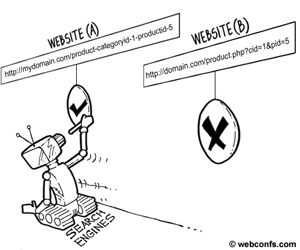VII.
Static Versus Dynamic URLs

Based on the previous section, you might have gotten the
impression that the algorithms of search engines try to humiliate
every designer effort to make a site gorgeous. Well, it has been
explained why search engines do not like image, movies, applets and
other extras. Now, you might think that search engines are far too
cheeky to dislike dynamic URLs either. Honestly, users are also not
in love with URLs like
http://domain.com/product.php?cid=1&pid=5
because such URLs do not tell much about the contents of the page.
There are a couple of good reasons why static URLs score better
than dynamic URLs. First, dynamic URLs are not always there –
i.e. the page is generated on request after the user performs some
kind of action (fills a form and submits it or performs a search
using the site's search engine). In a sense, such pages are
nonexistent for search engines, because they index the Web by
crawling it, not by filling in forms.

Second, even if a dynamic page has already been generated by a
previous user request and is stored on the server, search engines
might just skip it if it has too many question marks and other
special symbols in it. Once upon a time search engines did not index
dynamic pages at all, while today they do index them but generally
slower than they index static pages.
The idea is not to revert to static HTML only. Database-driven
sites are great but it will be much better if you serve your pages to
the search engines and users in a format they can easily handle. One
of the solutions of the dynamic URLs problem is called URL
rewriting. There are special tools (different for different
platforms and servers) that rewrite URLs in a friendlier format, so
they appear in the browser like normal HTML pages. Try the URL Rewriting Tool below, it will convert the cryptic text from the
previous example into something more readable, like
http://mydomain.com/product-categoryid-1-productid-5.
|



